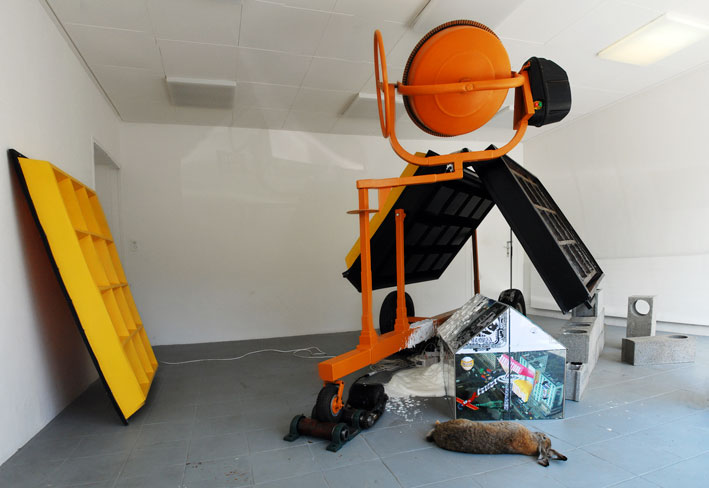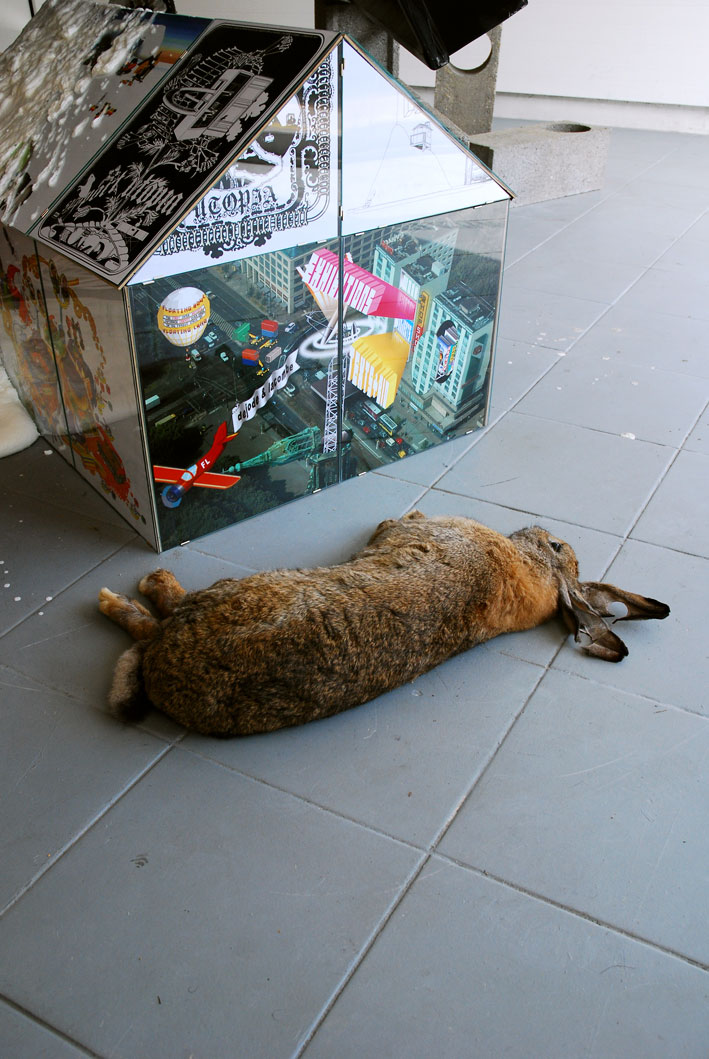 In
2001 the French artists Sophie Dejode and Bertrand Lacombe launched Floating
Land,
a fictional nation state occupied by the duo and an expanding network of artists,
as a radical alternative to the production and exhibition processes that regulate
the contemporary art world. Since then, this imaginary island is set adrift on
the ocean of the art world, dropping anchor for each new exhibition in order
to expand its physical and fictional borders.
In
2001 the French artists Sophie Dejode and Bertrand Lacombe launched Floating
Land,
a fictional nation state occupied by the duo and an expanding network of artists,
as a radical alternative to the production and exhibition processes that regulate
the contemporary art world. Since then, this imaginary island is set adrift on
the ocean of the art world, dropping anchor for each new exhibition in order
to expand its physical and fictional borders.
Floating Land operates as an independent state in the confines of the museum or gallery space. The laws and customs of the island are applied within this territory, subjugating the control of the host structure. When Dejode & Lacombe select the artists they wish to participate in the exhibition, they effectively undermine the institution’s role as an artistic authority. The duo take the place of the curator, substituting aesthetic or political selection criteria with that of artistic and human exchange.
The invited participants join the community and take on the nationality of Floating Lander for the duration of their stay. Participation in the exhibition provides the artists with the opportunity to continue their own artistic concerns in an atmosphere of collective exchange. It offers a unique occasion for discussion and interaction between different artistic practises in an art world increasingly dominated by the commercial paradigm of rapid and lucrative production.
The pieces produced by the invited artists are integrated into the super-structure of Floating Land’s ever evolving landscape. The duo use the exhibition process as a system for the production of the sculptural elements that form the island. Dejode & Lacombe negotiate the presentation of Floating Land in exchange for a production budget. Thus, they actively subvert the exhibition system by using the production money to further establish their independent state, which itself rejects the values of the host institutions. This process also guarantees the unlimited expansion of the Floating Land, whose elements multiply like a virus in the contemporary art machine.
The plastic environment that constitutes Floating Land further establishes the anarchistic precepts that form the basis of Dejode & Lacombe’s work. The first manifestation of Floating Land, which took place at the MAC Lyon in 2001, was a military installation formed from watch towers, sand bags and wooden bridges, while the museum’s information desk was transformed into a bunker. This set the tone for the future; Floating Land is not a welcoming island paradise open to all, but rather an independent state whose frontiers one crosses at one’s own peril.
The following exhibition at the Neon Galley, Lyon, reinforced this idea of inaccessibility. The artists invited the public to explore the depths of Floating Land. Thus, a series of winding, tight wooden tunnels lead the visitor on a disorienting journey ending unexpectedly at an underground Japanese restaurant. Indeed the tunnel or path is a recurring feature of Floating Land. In the exhibition Kamikaze 2089 , the visitor was obliged to follow a pathway closed in by wire-fencing. This labyrinthine trail produced a feeling of insecurity and repression in the visitor accustomed to circulating freely in the exhibition space.
In the same way that the viewer is confronted with an ambiguous environment, so to are the participating artists. Dejode & Lacombe cynically demonstrate the limits of their utopian artistic community through the mini-motorbike race/performance, Floating Bowl. Artists who have been working side by side to create an exhibition are forced into competition with one another on the opening night. Furthermore, a jury of art critics and museum directors are invited to judge the participants on randomly selected criteria. In this way, the duo vividly illustrate the inherent rivalry between artists and the arbitrary nature of success in the art world.
Dejode & Lacombe’s Floating Land can also be seen as an acerbic response to the current trend in contemporary art for interactive installation pieces, known as relational aesthetics. What at first appears to be an adventure park of fun attractions and fast-food, an art world Disney Land, soon reveals itself to be an empty, consumer ‘unfriendly’ environment. The fast-food stall proposing a dubious stork burger is permanently closed, while the space is devoid of any possibility of participation. The viewer is confronted with the vacuity of the proposed entertainment and an unsettling feeling of exclusion.
Floating Land is not only a project that evolves physically and geographically, but also conceptually. The next step in the project will be an exploration of the possible relations between artists and the public as the Floating Landers will remain resident, working and living in the Floating landscape throughout the exhibition. In this way, Dejode & Lacombe continue their radical response to the established art system by reacting from within, just as a virus entering a computer alters the configuration of the mainframe from the inside.
Katie Kennedy
Vue de l'exposition à l'espace kugler





